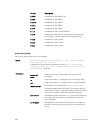
seq 15 permit 30.1.2.0/24
Dell#
Standard IP ACL Commands
When you create an ACL without any rule and then apply it to an interface, the ACL behavior reflects an
implicit permit.
The platform supports both Ingress and Egress IP ACLs.
NOTE: Also refer to the Commands Common to all ACL Types and Common IP ACL Commands
sections.
deny
To drop packets with a certain IP address, configure a filter.
Syntax
deny {source | any | host {ip-address}} [no-drop]
To remove this filter, you have two choices:
• Use the no seq sequence-number command if you know the filter’s
sequence number.
• Use the no deny {source [mask] | any | host ip-address}
command.
Parameters
source Enter the IP address in dotted decimal format of the network
from which the packet was sent.
any Enter the keyword any to specify that all routes are subject
to the filter. You can enter any of the following keywords to
specify route types.
• bytes — Enter the keyword count to count packets the
filter processes.
• count — Enter the keyword bytesorder to count bytes
the filter processes.
• dscp — Enter the keyword dcsp followed by the DCSP
value to match to the IP DCSCP values. The range is from
0 to 63.
• fragments — Enter the keyword fragments to use
ACLs to control packet fragments.
• order — Enter the keyword order to specify the QoS
order of priority for the ACL entry. The range is from 0 to
254 (0 is the highest priority and 254 is the lowest; lower-
order numbers have a higher priority). The default is, if
you do not use the keyword order, the ACLs have the
lowest order by default (255).
230
Access Control Lists (ACL)


















